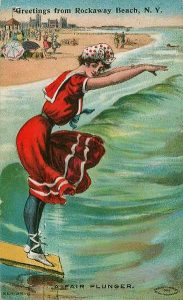 Summer will soon be upon us — the time of year when many of us will be seen in swim wear or, as it used to be called, bathing costumes. Summer wasn’t always synonymous with a seaside vacation. A convergence of factors in the mid-nineteenth century introduced the annual ritual to American life.
Summer will soon be upon us — the time of year when many of us will be seen in swim wear or, as it used to be called, bathing costumes. Summer wasn’t always synonymous with a seaside vacation. A convergence of factors in the mid-nineteenth century introduced the annual ritual to American life.
Railways made it possible for the average American to reach the sea, but that didn’t mean men and women could expose bare flesh. The swimming costume called a Princess Suit took its inspiration from  Amelia Bloomer and the Rational Clothing Movement. It was a low-hanging dress over pantaloons, called bloomers. The suits were made of heavy opaque flannel that had a tendency to rise when wet unless weights were sewn into the hems.
Amelia Bloomer and the Rational Clothing Movement. It was a low-hanging dress over pantaloons, called bloomers. The suits were made of heavy opaque flannel that had a tendency to rise when wet unless weights were sewn into the hems.
 Princess Suits were only to be worn in the water, so women changed in Bathing Machines. There were two doors. On the shore, the bather entered the high-walled box and changed into the Princess Suit. There was a high shelf to keep the street clothes dry. The Bathing Machine was then wheeled into the water, usually by a horse and driver. The bather then exited through the seaside door and went down the steps to enter the water. Men and women had separate bathing areas, and the machine blocked any view from the shore.
Princess Suits were only to be worn in the water, so women changed in Bathing Machines. There were two doors. On the shore, the bather entered the high-walled box and changed into the Princess Suit. There was a high shelf to keep the street clothes dry. The Bathing Machine was then wheeled into the water, usually by a horse and driver. The bather then exited through the seaside door and went down the steps to enter the water. Men and women had separate bathing areas, and the machine blocked any view from the shore.
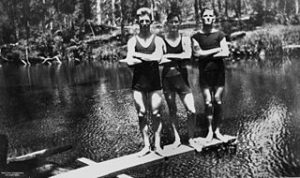 Men also kept themselves covered. It was illegal for men to go shirtless on the beach until the 1930s.
Men also kept themselves covered. It was illegal for men to go shirtless on the beach until the 1930s.
In 1907 swimmer Annette Kellerman created a sensation when she wore a form-fitting one piece suit as she demonstrated swimming and diving in a Boston Vaudeville show. The suit lacked a skirt which made it indecent. Kellerman allegedly told the judge she couldn’t swim wearing more fabric than a clothesline. The judge ruled she had to wear the skirt until she entered the water.
In 1913 Carl Jantzen created the first functional two-piece bathing suit that a woman could actually swim in. It was a loose fitting one piece with shorts at the bottom and short sleeves at the top.
In 1914 By the Beautiful Sea was a popular hit. This three minute rendition of the song by Harold Atteridge and Harry Carroll features photos from the age.
Swim suit styles changed in the 1930s. Men no longer wore tops. Women had a plunging neckline at the back, and the sides could be cut away. The use of latex and nylon allowed suits to hug the body more closely. Tanning also became a popular pastime.
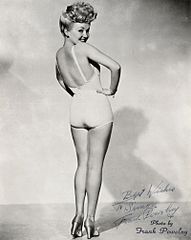 During the 1940s war time production rules required a ten percent reduction in the fabric used in women’s swimwear. Two-piece suits with a bare midriff began to appear, though they were not immediately popular. Betty Grable’s famous 1943 pin-up picture demonstrates the look most women were after.
During the 1940s war time production rules required a ten percent reduction in the fabric used in women’s swimwear. Two-piece suits with a bare midriff began to appear, though they were not immediately popular. Betty Grable’s famous 1943 pin-up picture demonstrates the look most women were after.
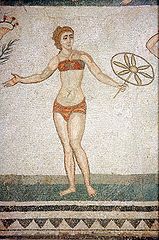 In 1946 designer Louis Reard unveiled the first bikini. Named after Bikini Atoll, a nuclear testing site, the suit was said to inspire a visual explosion. Unable to find a “respectable” model, the job went to Micheline Bernardini, a nude dancer from the Casino de Paris. One could argue his design wasn’t entirely original, as seen in this mosaic.
In 1946 designer Louis Reard unveiled the first bikini. Named after Bikini Atoll, a nuclear testing site, the suit was said to inspire a visual explosion. Unable to find a “respectable” model, the job went to Micheline Bernardini, a nude dancer from the Casino de Paris. One could argue his design wasn’t entirely original, as seen in this mosaic.
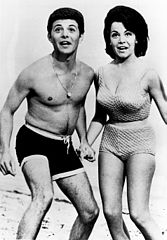
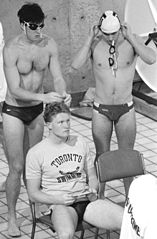 Men’s swimwear underwent similar changes from full coverage in the early twentieth century, to bare chests and rayon shorts in the 1930s to Frankie Avalon’s fashion statement in a 1960s Beach Blanket movie. Speedos were popular in the 1980s, and then the trend shifted back to Board Shorts, sometimes called Surf Trunks.
Men’s swimwear underwent similar changes from full coverage in the early twentieth century, to bare chests and rayon shorts in the 1930s to Frankie Avalon’s fashion statement in a 1960s Beach Blanket movie. Speedos were popular in the 1980s, and then the trend shifted back to Board Shorts, sometimes called Surf Trunks.
Nowadays the range of swimwear goes from almost non-existent to full coverage and nothing seems shocking.
???
Illustrations from Wikimedia Commons.
Greetings from Rockaway Beach. 1910. Public Domain.
Two Women on Sand. 1920. Public Domain.
Women Posing near Bathing Machine. 1902. Public Domain.
Three Men on a Diving Board. Public Domain.
Annette Kellerman. 1909. Public Domain.
Betty Grable. 1943. Public Domain.
Mosaic at Villa del Casale. Public Domain.
Frankie Avalon and Annette Funicello. About 1963. Public Domain.
Swim Meet at Toronto. 1987. By Hy Crutchett. Creative Commons Attribution.
Surf Trunks. 2007. By x-eyedblonde. Creative Commons Attribution.
“From Tank Tops to Briefs.” Daily Mail. June 8, 2016.
Andrea Cheng. “See How Swimsuits Have Evolved.” InStyle. May 19, 2016.
Kiri Picone. “Appreciate Your Bikini.” All That Is Interesting. Feb. 27, 2018.

Sandra Wagner-Wright holds the doctoral degree in history and taught women’s and global history at the University of Hawai`i. Sandra travels for her research, most recently to Salem, Massachusetts, the setting of her new Salem Stories series. She also enjoys traveling for new experiences. Recent trips include Antarctica and a river cruise on the Rhine from Amsterdam to Basel.
Sandra particularly likes writing about strong women who make a difference. She lives in Hilo, Hawai`i with her family and writes a blog relating to history, travel, and the idiosyncrasies of life.

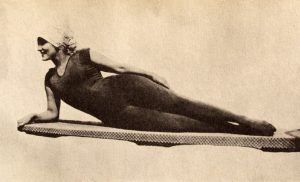
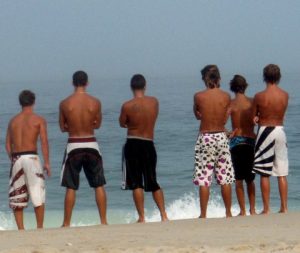

Love all the sun fashions from the early 1900s-1970! Sweet video! Stay in the shade!
Happy Summer!<3, Kel
I remember that my father had a wool “bathing costume” – I have a mental image of his wearing it when we went to Cape Cod in the early 40’s. It was one piece – sorts and a sleeveless top. My mother wore something with a skirt. Then my father started wearing wool “trunks”. If I come across photos of them in their “bathing costumes” from that era I will send you a copy.
These days I wear a one piece “tankin”suit for the pool -much like some female triathletes wear -without sleeves – mainly because I hate bathing suits that craw up my rear. I rarely go to the beach – never been a fan of sunbathing – and get enough sun running around in shorts and a tank when I hit the road or the track.
The women’s skirts were still around in the 1950s, so was the so-called modesty panel. Thanks for sharing “live” events.